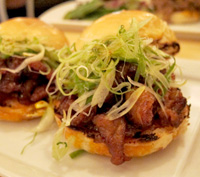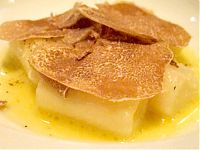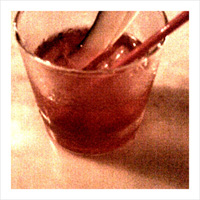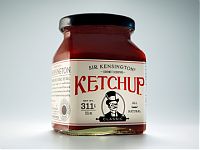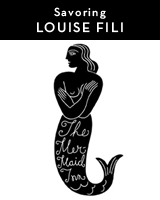A Wine Story About Bees (Buzzed by Older Wines)
by Cynthia Sin-Yi Cheng
March 1, 2006
Around town, in this busy month of wine tasting, I definitely felt like one busy bee fleeting from one event to the next. To be honest, I have always found big industry tastings a bit overwhelming: Too many choices, too many people, hard to have a one-on-one conversation with your favorite winemaker even when he/she is pouring right in front of you, not to mention all the maneuvering required to dodge your neighbors’ spitting. Everyone is distracted by someone or something. I find it best to have a plan of attack and stay focused on a succinct list of producers. The comprehensive portfolio tastings are great for discovering new wineries, tasting the latest vintages and getting a general overview of a large number of producers. In terms of education though, I personally benefit more from smaller gatherings, whether a structured seminar or an intimate winemaker luncheon.
So recently as I went from learning about biodynamic wines at Nicolas Joly’s master class during the third annual Return to the Terroir tasting to getting a glimpse of current South American developments at the Wines of Chile: The Next Generation event — where I fell in love with the Pinot Noirs coming out of San Antonio — I left each experience feeling a bit wine-wiser.
The high point, however, came at the vertical tasting of Maison Joseph Drouhin’s (MJD) top-of-the-line wine: Beaune Clos des Mouches. The icing on the cake was that both Robert and Véronique Drouhin would be present. From the moment I RSVP’d to this rare gathering, I anticipated being wowed by these wines. But I had not realized that, by the end of this memorable tasting, I would bridge an important part of my wine education: getting acquainted with the taste of older burgundies.
Fate would have it that Robert Drouhin contracted laryngitis just before the tasting. An entire mini-speaker system was set up to support his weak voice. Under less-than-perfect circumstances, it was especially impressive that not only did we hear him perfectly — at one point, he even abandoned the temperamental mini-mic altogether — but he was one captivating speaker. Robert got my attention full heartedly. He could have “sold” his product with his charm, but the sincerity and knowledge with which he spoke about his prized Clos des Mouches blew me away. I listened.
The history goes: During the 16th Century, the south-facing slopes of the Clos des Mouches in the Côte de Beaune were ideal grounds for beekeeping. Mouche normally means “fly” in French but in the patois of Burgundy, bees were called honey flies (mouches à miel). So the precious lands where the Premier Cru vines of the Clos des Mouches (“Enclosure of the Honeybees”) grow today used to be filled with beehives. One close look at the wine label and you will see a pack of bees flying atop the word “Clos.”
Robert talked about the bees, his close-knit family (all four of his children presently manage a sector of MJD), how a Drouhin before him dug through old tax books looking for the most heavily-taxed plots to select the best vineyards and the daily eleven o’clock tasting en famille back in Beaune. His daughter, Véronique, who is the winemaker for Domaine Drouhin Oregon, accompanied him; seamlessly, the two complemented each other while showing mutual respect as colleagues and family members.
They both led the tasting, which included five Clos des Mouches whites and six reds. For the whites, we started with the most recent 2004 vintage and worked through 2002, 2000 and 1999 and back to a 1992. With the wines lined up in front of me, I observed that the youngest wine of the line-up, the ’04, revealed more concentration than the ’02 and ’00 just by the color of its tone. One sip, and it was confirmed. In discussing the ’04, we agreed that it was an easy-to-drink wine that should be enjoyed now. Of the younger wines, I took a special liking to the ’02 with its pure citrus notes; it had good structure complemented by elegance.
My favorite was the unexpectedly youthful ’92. The honeyed nose and luscious viscosity gave away a bit of its age, but otherwise it expressed a lively freshness for a fourteen-year-old Chardonnay. One wine journalist at the tasting blurted out it was “very sexy!” Véronique proceeded to praise the 1992 vintage as a great year for white burgundy in general.
While Clos des Mouches is known for whites, the reds weren’t exactly stepsiblings tagging along just for the ride. A point to note: around two percent of Pinot Gris — the original white varietal of the region — is added to the final blend to round off the wine. We started with the ’03 vintage. Again and again, this vintage that everyone was anxious about has been turning heads. The heat wave in 2003 resulted in very fruit-forward and luscious wines that are approachable and showing very well right now.
The Clos ’03 was glowing: it had a perfect burgundy hue with a typical Pinot red-berry nose that was enticing and filled with promise of what’s to come. I was worried that the wine might be too uni-dimensional but it wasn’t: the acidity worked hand-in-hand with the fruit to create a balanced structure. Suffice it to say, this wine is drinking beautifully now. Asked about potential for ageing, Robert gave a surprisingly high number — forty years!
We continued with the ’02, ’99, ’90, ’85 and ’76. It was a lesson just to see the tone gradation of the wines from the bright plum of the ’03 to the dull chestnut shade of the ’76. The colors hint at what to expect in terms of taste, but I imagine I was the only person in the room who had never been exposed to burgundies from the 70s and 80s. As we traveled back in years, I noticed a bit more fruit was lost with each vintage. This was the most interesting thing because even older bordeaux retains more noticeable fruit. A senior journalist in the room pointed out that the differences between the younger and older wines could also be traced back to changes in winemaking styles. The old burgundies were more esoteric: as I started to get truffle notes and spices, a rustic side started to show. I was elated because my senses of taste and perception were being challenged. I was in an unknown land. It intrigued me. I realized my palate was evolving.
The theme of older wines seems to have popped up a lot recently. Just a few weeks ago, Alain Dominique Perrin of Chateau Lagrézette lamented on the lack of readily available older wines on the market. Introducing the 1997 Leroy Bourgogne by the glass at Gaia restaurant, wine director Olivier Flosse obviously was aiming at the same point. Average wine drinkers rarely have the opportunity to taste older wines if they aren’t easily found by the glass or in retail stores, so their palates are dictated by the youthful taste of recent vintages.
I learned that appreciating older burgundies is an “acquired taste” in the best sense of the concept. I’m thinking oysters, sea urchin and truffles. But it isn’t every day that you will see old burgundies lying around. Unless as David Munksgard, the winemaker at Iron Horse Vineyard reminded me, “you have great friends or relatives who buy young and cellar them!” Or if you’re lucky enough to find yourself savoring older vintages shared by the owners of a top Burgundy house.
Suggested retail price:
Clos des Mouches (white)
2004 — $70
2002 — $91
Clos des Mouches (red)
2003 — $76
2002 — $78



